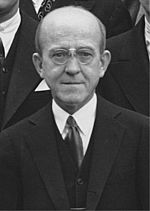Oswald Avery facts for kids
Quick facts for kids
Oswald Avery Jr.
|
|
|---|---|

Oswald Avery Jr. in 1937
|
|
| Born |
Osward Theodore Avery Jr.
October 21, 1877 |
| Died | February 20, 1955 (aged 77) |
| Nationality | American |
| Known for |
|
| Awards | ForMemRS Copley Medal (1945) |
| Scientific career | |
| Fields | Molecular biology |
| Institutions | Rockefeller University Hospital |
Oswald Theodore Avery Jr. (October 21, 1877 – February 20, 1955) was a scientist born in Canada. He became an American physician and medical researcher. He spent most of his working life at the Rockefeller University Hospital in New York City.
Avery was one of the first molecular biologists. He was also one of the first people to study immunochemistry. This is the study of how the body's immune system works.
He is famous for an important experiment. This experiment was published in 1944 with his teammates Colin MacLeod and Maclyn McCarty. Their work proved that DNA is the material that carries genetic information. This means DNA tells our bodies how to grow and what traits we will have.
Nobel laureate Arne Tiselius said that Avery was one of the most deserving scientists to receive the Nobel Prize. Avery was nominated many times but never won.
About Oswald Avery
Oswald Avery was born in Halifax, Nova Scotia, Canada. His father was a Baptist minister. In 1887, his family moved to New York City.
Avery earned his first degree in 1900 from Colgate University. He then got his medical degree in 1904 from the Columbia University Vagelos College of Physicians and Surgeons. He worked as a doctor in New York City until 1907. After that, he became a researcher at Hoagland Laboratory in Brooklyn, New York.
In 1934, Avery had surgery for a thyroid problem called Graves' disease. In 1936, he was chosen to be a member of the American Academy of Arts and Sciences.
His Big Discovery
For many years, scientists thought that genetic information was stored in proteins inside cells. Oswald Avery, along with Colin MacLeod and Maclyn McCarty, worked to solve the mystery of inheritance. They continued the research started by Frederick Griffith in 1927.
Avery officially retired from the Rockefeller Institute in 1943. But he kept working for five more years, even though he was in his late sixties.
In their important experiment, they used a type of bacteria called Streptococcus pneumoniae. They mixed dead, harmful bacteria with living, harmless bacteria. This mix caused a deadly infection. This showed that something from the dead bacteria changed the harmless ones.
Avery and his team discovered that this "something" was DNA. This meant DNA, not protein, carried the instructions for life.
Alfred Hershey and Martha Chase did more research in 1952. Their Hershey–Chase experiment further supported Avery's findings. These discoveries prepared the way for Watson and Crick. They later found the helical (spiral) shape of DNA. This led to the start of modern genetics and molecular biology.
Avery wrote to his younger brother Roy about his work. He said, "It's lots of fun to blow bubbles but it's wiser to prick them yourself before someone else tries to." This meant it's good to test your own ideas before others do.
Nobel laureate Joshua Lederberg said that Avery's lab created the "historical platform of modern DNA research." He added that it started the "molecular revolution" in genetics and science.
See also
 In Spanish: Oswald Avery para niños
In Spanish: Oswald Avery para niños

